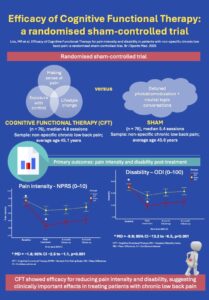This blog is based on our recent randomized controlled trial (Efficacy of cognitive functional therapy for pain intensity and disability in patients with non-specific chronic low back pain: a randomised sham-controlled trial. Lira, MR et al. Br J Sports Med. 2025). Our study is a randomized controlled trial (RCT) which investigated the efficacy of cognitive functional therapy (CFT) in patients with non-specific chronic low back pain (CLBP).
Why is this study important?
CLBP is one of the most prevalent, costly, disabling public health problems worldwide. The number of individuals affected by this condition will show a significant increase by 2050 (1). In this scenario, since biophysical, psychological and social factors contribute to the persistence of CLBP and disability, biopsychosocial interventions are recommended (2). However, there is still a gap in clinical practice regarding how clinicians can approach the model (3).
What Cognitive Functional Therapy (CFT) is and what is the evidence of CFT approach?
CFT is a therapeutic approach firmly anchored in the biopsychosocial model (4). It comprises three components: making sense of pain, exposure with control, and lifestyle change. CFT is a physiotherapy-led intervention that uses a flexible clinical-reasoning approach, which is based on information obtained by interview and physical examination, to identify movements, postures, pain-related cognitions and beliefs, emotions and lifestyle factors contributing to pain and disability.
Previous systematic reviews with meta-analysis showed that the certainty of evidence of CFT for reducing pain and disability in CLBP was very low to moderate (5, 6, 7). A major limitation of these studies was the lack of participant blinding (6), which means participants who know they are receiving a specific treatment may change their behavior. Efficacy studies are important because it helps to understand if an intervention shows active effects greater than placebo/sham effects. “Placebo” or “sham” interventions are used in RCT for blinding and to control for the psychosocial context of the treatment (contextual effects) and nonspecific effects (like spontaneous remission) (8). Every intervention should be submitted to an efficacy proof (compared to a placebo/sham) before being recommended in clinical practice.
How did the study go about this?
Our study is the first to study efficacy for CFT intervention. We recruited 152 participants with CLBP which were randomized into two groups: (I) group CFT (n=76) and, (II) group sham (n=76). The CFT group (45.1 years) received an average of 4.8 sessions. The sham group (45.6 years) received an average of 5.4 sessions. This intervention included two components: (1) detuned photobiomodulation + (2) neutral topic conversations.
All participants were assessed pre- and post-intervention, as well as followed up for 3 and 6 months after randomization. Our primary outcomes were pain intensity and disability (ODI) post-intervention. We also assessed pain self-efficacy, global perceived effect of improvement and functioning.
What did the study find?
- Three analyses suggested that patient blinding was successful in our study.
- The CFT group demonstrated clinical improvement in the primary outcomes pain intensity (Mean Difference [MD]=−1.8; 95%CI −2.5 to −1.1) and disability (MD=−9.9; 95%CI −13.2 to −6.5) post-intervention when compared to the sham group.
- The effect observed post-intervention was consistently sustained during the follow-ups, favoring the CFT group.
- Our findings showed significant improvements in functioning, pain self-efficacy, and global perceived effect compared with the sham group.
What are the key take-home points?
This study fills a gap in the scientific literature showing that the effect of CFT intervention is greater than placebo/sham effects for reducing pain intensity and disability in CLBP. Our results encourage the use of CFT to manage CLBP in clinical practice.

References
(1) GBD 2021 Low Back Pain Collaborators. Global, regional, and national burden of low back pain, 1990-2020, its attributable risk factors, and projections to 2050: a systematic analysis of the Global Burden of Disease Study 2021. Lancet Rheumatol. 2023 May 22;5(6):e316-e329.
(2) Hartvigsen J. et al. Lancet Low Back Pain Series Working Group. What low back pain is and why we need to pay attention. Lancet. 2018 Jun 9;391(10137):2356-2367.
(3) Corp, N. et al. Evidence-based treatment recommendations for neck and low back pain across Europe: A systematic review of guidelines. Eur J Pain. 2021 Feb;25(2):275-295. Epub 2020 Nov 12.
(4) O’Sullivan, P. et al Cognitive Functional Therapy: An Integrated Behavioral Approach for the Targeted Management of Disabling Low Back Pain. Phys Ther. 2018 May 1;98(5):408-423.
(5) Thiveos L, Kent P, Pocovi NC, O’Sullivan P, Hancock MJ. Cognitive Functional Therapy for Chronic Low Back Pain: A Systematic Review and Meta-Analysis. Phys Ther. 2024 Dec 6;104(12):pzae128.
(6) Zhang J, Jiang N, Xu H, Wu Y, Cheng S, Liang B. Efficacy of cognitive functional therapy in patients with low back pain: A systematic review and meta-analysis. Int J Nurs Stud. 2024 Mar;151:104679.
(7) Devonshire JJ, Wewege MA, Hansford HJ, Odemis HA, Wand BM, Jones MD, McAuley JH. Effectiveness of Cognitive Functional Therapy for Reducing Pain and Disability in Chronic Low Back Pain: A Systematic Review and Meta-analysis. J Orthop Sports Phys Ther. 2023 May;53(5):244–285.
(8) Vase L. Can insights from placebo and nocebo mechanism studies help improve randomized controlled trials? Clin Pharmacol Ther 2019;106:1169-71.